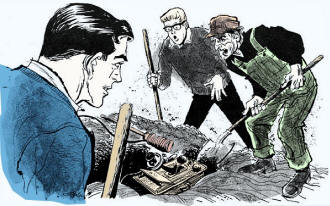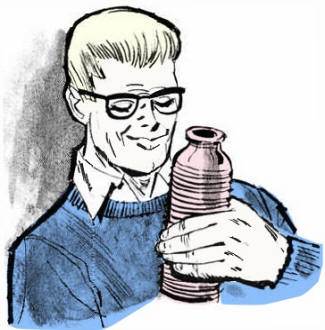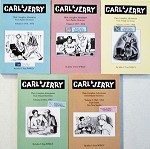Carl & Jerry: The Educated Nursing Bottle
|
|||||||
Throughout John T. Frye's series of "Carl and Jerry" stories, there are times when one or the other needs to convince his technosleuth buddy that a particular project is worthy of undertaking. In the early days while the boys were still in high school, Jerry was typically portrayed as an overweight, rather lazy guy who, while well versed in electronics and mechanics, preferred to do his thinking and acting while sitting or lying down. He always rose to the event and did his part to solve a crime, play a joke on a friend, or solve a problem plaguing their combined interest in amateur radio and remote controlled model boats and airplanes. By the time they got to Parvoo* University as electrical engineering students, he had outgrown most of those tendencies. In this 1963 issue of Popular Electronics magazine is an example of Jerry being the motivator and "expert" on the subject of atomic magnetometers. With the ready availability of low noise, high gain opamps and cheap audio frequency digital oscilloscope systems, I wonder why the described type of atomic metal detector is not widely used today, rather than the classic magnetic coil? *Some believe Parvoo is a play on Purdue, in Indiana, where the boys lived. Carl & Jerry: The Educated Nursing Bottle A Carl and Jerry Adventure A Carl and Jerry Adventure
By John T. Frye W9EGV
Carl and Jerry, on their way home from Parvoo University for Easter vacation, were driving the back roads, enjoying the budding signs of spring so welcome after the long and bitter winter. "Well, what do we do this vacation?" Carl asked as they rolled along a gravel road. "I'd like to forget all about books for a few days and build something wild in the lab the way we used to." "We'll think of something," Jerry promised. "Say, what's that funny-looking little hill in the field over there to the left?" "That's an old Indian burial mound," Carl replied. "I used to hunt arrowheads on it when I visited a cousin living near here." "Hey! That reminds me. Did you ever hear of a Differential Proton Precession Magnetometer ?" "Nope," Carl confessed, "and I wouldn't wish a name like that on a dog. Anyway, what's the connection between Indian mounds and your proton whatchamaycallit?" "I read in the November, 1963, issue of the Indiana History Bulletin that such an instrument is being used to make a magnetic survey of the big Angel Mounds archaeological site in the southern part of the state. Mr. Glen A. Black is directing the operation for the Indiana Historical Society, and he wrote the article which got me curious. I've been doing some digging - no pun intended and I find the proton magnetometer a very interesting gadget." "Try and convince me," Carl challenged. "O.K. The proton magnetometer was developed at Oxford University. It's essentially a device to accurately measure very small magnetic fields, such as the fraction of a gauss-between 49,000 and 61,000 gammas - presented by the earth's magnetism. The funny part about the whole thing is the 'complicated' basic apparatus: it consists of a coil of wire wound around a half-pint plastic bottle of water!" "Go on. Now you've got me curious," Carl admitted. "The proton, or hydrogen nucleus, acts like a tiny bar magnet spinning on its long axis. It has both magnetic and gyroscopic properties. As a magnet, it aligns itself with the magnetic field of the earth in its locality just like a compass needle. If it's temporarily twisted out of alignment, it 'gyrates' back into line with the wobbling motion of a spinning top. The frequency of those gyrations is directly proportional to the strength of the magnetic field." "Where does the jug of water and the coil come in ?" "Water is two-thirds hydrogen atoms, and a half-pint contains a billion billion protons, give or take a proton or so. Now if you send a direct current through the coil of wire around the bottle for a few seconds, the resulting magnetic field twists the protons out of alignment with the weaker magnetic field of the earth. Remove the current and the protons start waltzing around to get back into their original position. The moving, combined magnetic field of all those gyrating protons cuts the turns of the coil and produces a small a.c. voltage in it. The frequency of that voltage is an exact indication of the strength of the magnetic field." "That's neat!" Carl exclaimed. "How's it used in archaeology ?" "It was first put to use at Sybaris in southern Italy. In the sixth century B.C., enemies from the neighboring city of Croton destroyed Sybaris, leveled it, and diverted the Crathis River to flow over the site and cover it with silt." "I somehow get the feeling the Crotoni didn't like the swinging Sybariti very much." "You better believe it. Anyway, the archaeologists didn't know where to look for the buried ruins. Italian soil in this region is magnetic, but the limestone from which the Sybarites originally built their wall is not. When they surveyed the flat plain of the ancient river with the proton magnetometer they found abrupt changes in the magnetism of the ground below by which they could trace the location of the buried wall for nearly a mile. "Three different proton magnetometers have been used at Angel Mounds here in Indiana with pretty good results. The first was the Model M-49 built by Varian Associates of Palo Alto, California. Another was an English model, the Elsec 592/A, built by Littlemore Scientific Engineering Company. The one they're using now, the LMB II, was built by a man named Scollar at the Rheinisches Landesmuseum in Bonn, Germany. All three will show the presence of many buried materials by indicating slight differences in the strength of magnetic readings taken directly above." "That's it!" Carl exclaimed. "We'll build a proton magnetometer and survey that Indian mound back there!" "Now hold on," Jerry demurred. "The proton magnetometer is simple in theory but very sophisticated in practice. The voltage output of the coil is only about a microvolt. That means you need a lot of noise-free amplification before you can measure the frequency. And you should measure that frequency to approximately one part in 25,000. Protons normally make about 2000 gyrations per second at the earth's surface. A typical reading would be 2000.64 cycles per second. Increasing the magnetic field five gammas (0.00005 gauss) raises the frequency only to 2000.84 cycles. Being able to measure point-two of a cycle change at that frequency takes real good equipment." "Aw come on! Don't tell me Parvoo has educated the experimenter out of you. We used to do a lot of things because we didn't know they couldn't be done. Where's your old make-do spirit?" "O.K., O.K.! You've made your point. I'm game. I admit I have a couple ideas I'd like to try." "So what are we waiting for?" Carl asked with a pleased grin as his foot mashed down on the accelerator. THE FIRST THING the boys did the next morning was buy a plastic nursing bottle and wrap the whole length of it with No. 22 enameled wire and connect the ends to a coaxial fitting. The next few hours were spent revamping a high-gain transistorized amplifier they had built previously. They installed their best low-noise transistor in the front end and used tuned circuits to peak the amplifier fairly sharply at 2000 cycles to get maximum gain. Finally they were satisfied that the one-microvolt signal from the coil would produce the 30 millivolts or so Jerry said they needed. "How are we going to measure the frequency ?" Carl wanted to know. "We don't need to measure the frequency - all we need to know is the relative frequency change produced by a change in the magnetic field around the bottle. We'll use Lissajous figures." While talking he hooked the output of a code practice oscillator to the horizontal amplifier of the scope and adjusted the gain for a one-inch horizontal trace. The variable sine-wave generator was connected to the vertical amplifier and the gain adjusted for a one-inch vertical trace. When both signals were going through the amplifiers, a one-inch square of light filled with moving lines appeared on the scope face, but when Jerry set the frequency of the generator exactly to that of the code practice oscillator, a kind of nervous circle was displayed. The slightest change in the generator frequency set this hoop of light to turning one way or the other. "That circle shows both oscillators are running at the same frequency with a ninety-degree phase shift," Jerry said, thinking out loud. "The slightest difference in frequency will set the pattern moving, and the number of revolutions it makes a second is the number of cycles of difference. If it takes ten seconds to make a revolution, that means there's only one-tenth of a cycle difference between the two frequencies, right ?" "Right. So what next, genius?" Carl asked. "Let's get busy and build the most stable 2000-cycle audio oscillator we can. We'll use a vernier control so we can vary it a few cycles either way." They decided on a Wien-bridge oscillator and built it as ruggedly as they could, using air-dielectric capacitors, precision resistors, and VR tubes to hold the voltage steady. A small variable capacitor permitted the frequency to be varied a few cycles in either direction. The completed oscillator was connected to the horizontal scope amplifier. Coaxial cable from the coil around the bottle went to a switching box. When a button on this box was pushed, an ampere of current from a battery was sent through the coil. Releasing the button connected the coaxial cable to the input of the transistorized amplifier going to the vertical scope amplifier. After the bottle was filled with water and placed on the floor in an east-west position, Jerry held the button down for six seconds and then released it while both boys eagerly watched the scope. The horizontal line traced by the audio oscillator expanded to a rectangle, held there for a few seconds, and then slowly collapsed. "We're getting a signal from the coil!" Jerry exulted. "Now let's see if we can tune our oscillator to the frequency put out by the protons." This took several tries, but finally they managed to get the desired glowing circle on the face of the scope every time the button was pushed and released. It was rather fuzzy-looking, indicating the presence of some noise, but it served the purpose. A magnet from an old speaker was placed on the floor near the bottle, and now when the button was pressed and released, the scope pattern revolved rapidly, showing a decided change in the frequency from the bottle. The audio oscillator frequency had to be increased several cycles to restore the circle to the face of the scope. Moving the magnet away from the bottle lowered the frequency. "We're in!" Carl gloated. "Tomorrow we'll take it out to the Indian mound and start digging up buried treasure! THE NEXT MORNING, low gray clouds were scudding across the sky and the south wind smelled of rain. Despite the unpromising weather, however, the boys couldn't wait to try their "bottle prospecting," as Carl termed it, and they loaded their gear into the car and took off. The farmer on whose land the mound stood readily gave them permission to try out their proton magnetometer, and even let them drive down a lane to the base of the mound. This helped, because they had borrowed a small, but heavy, gasoline-powered generator from the amateur radio club to power the non-transistorized equipment. Jerry fired this up in the trunk of the car and ran an extension cord from it to a card table set up near the bottom of the grassy knoll. The scope, audio oscillator, and preamplifier were placed on the table and turned on. A couple of hundred feet of RG58/U coaxial cable connected the sensing unit to the amplifier. After everything was thoroughly warmed up, Carl carried the bottle about a hundred feet up the slope of the mound and placed it, pointing in an east-west position, on the ground. Jerry had no trouble in synchronizing the audio oscillator with the signal sent back from the bottle after the button was pushed and released. While the farmer watched curiously, Carl moved the bottle about ten feet, and Jerry took another reading. The pattern moved ever so slowly until Jerry stopped it by readjusting the oscillator. They repeated this process several times without finding any indication of a sharp change in the magnetic field. In the meantime, the sky was growing darker and the wind was picking up. Carl began working down the slope toward the card table. "Hold it! The pattern's spinning like a merry-go-round!" Jerry suddenly shouted. "Move the bottle back to where it was and make sure our oscillator frequency hasn't shifted."
At a depth of only a few inches they ran into some cans, but the "bottle prospector" showed that the magnetic object was still in the earth below. Then the farmer's shovel struck rotting wood. The boys watched intently as he carefully moved aside the soft earth and revealed - an old-fashioned wall-type telephone! A single check with the magnetometer revealed that this was the source of the magnetism, and at this moment great drops of rain began spattering down. The farmer helped the boys hurriedly place their equipment inside the car, and then he got in with them as a heavy shower drummed on the roof. "Now I recall we had a trash pit there when I was a kid," the farmer mused. "I can't rightly remember how that old telephone got there, but I reckon the telephone company just left it when new phones were put in." "And after all these years the magnets in that crank-type ringer magneto still have enough moxie in them to drive the scope crazy," Jerry said. "Well, we didn't find any buried treasure, but our do-it-yourself proton magnetometer sure works." "I'm satisfied," Carl admitted, gazing fondly at the wire-wrapped nursing bottle he held in his hand.
Posted November 7, 2023
|
|||||||


 Carl & Jerry, by John T. Frye
Carl & Jerry, by John T. Frye